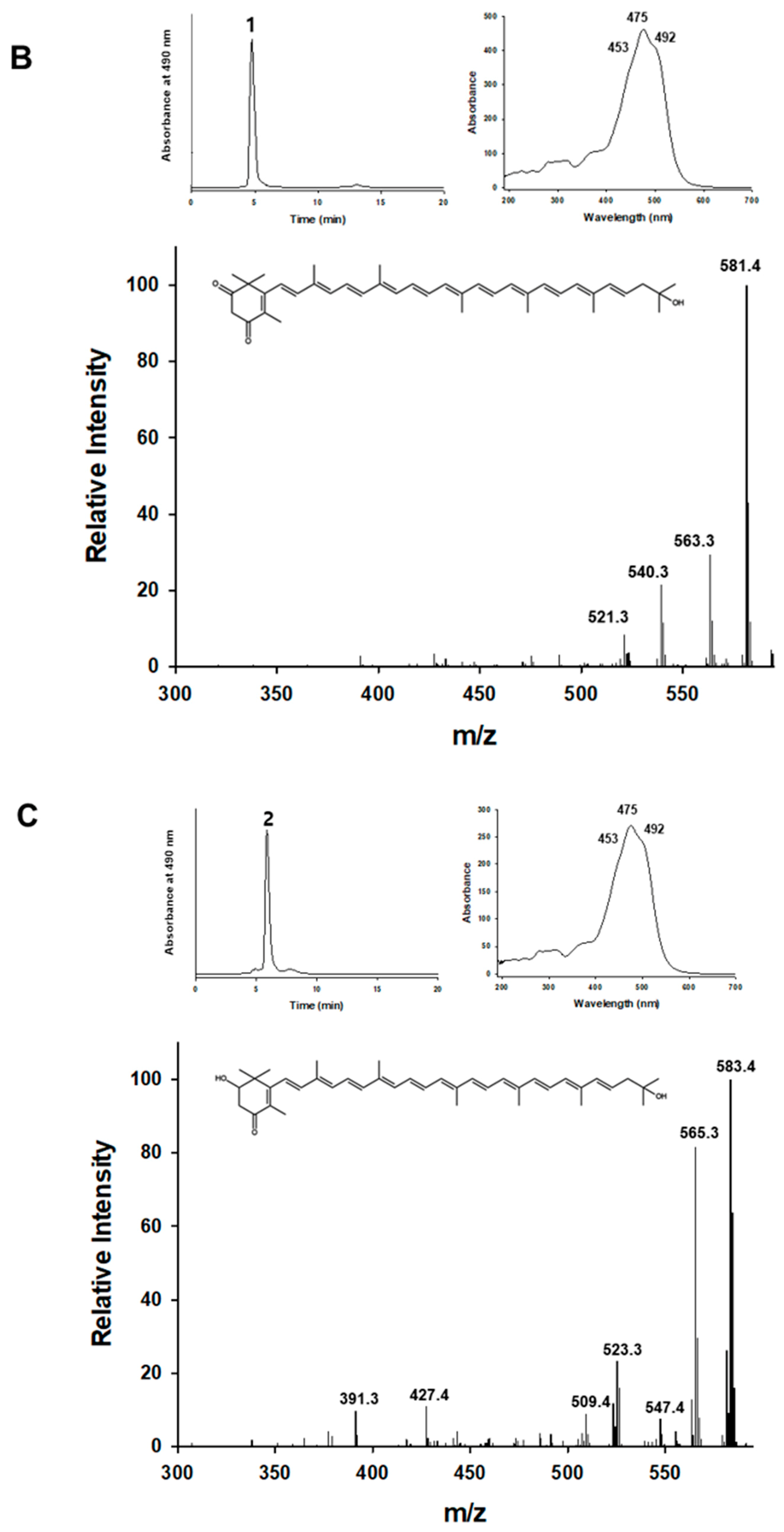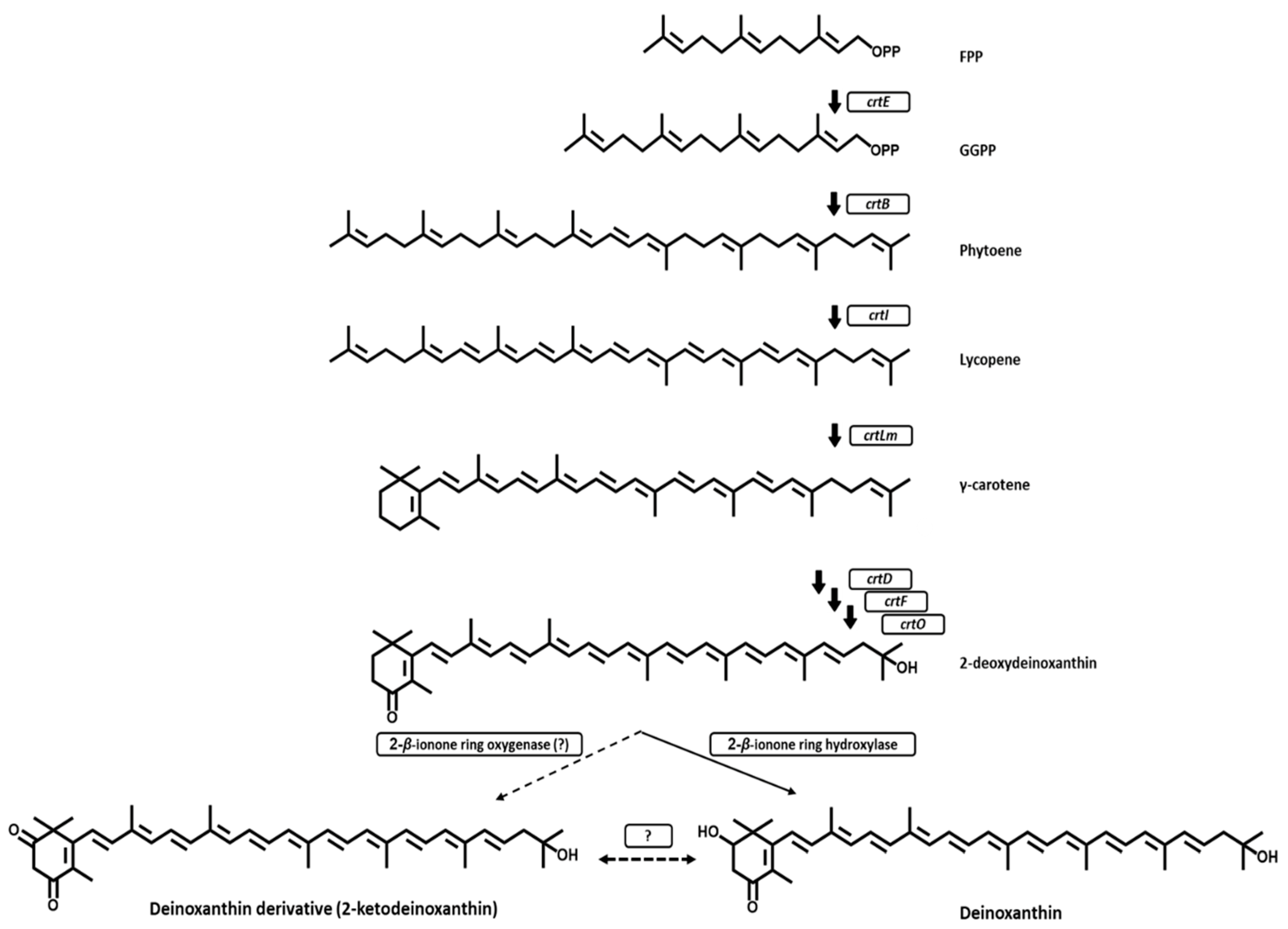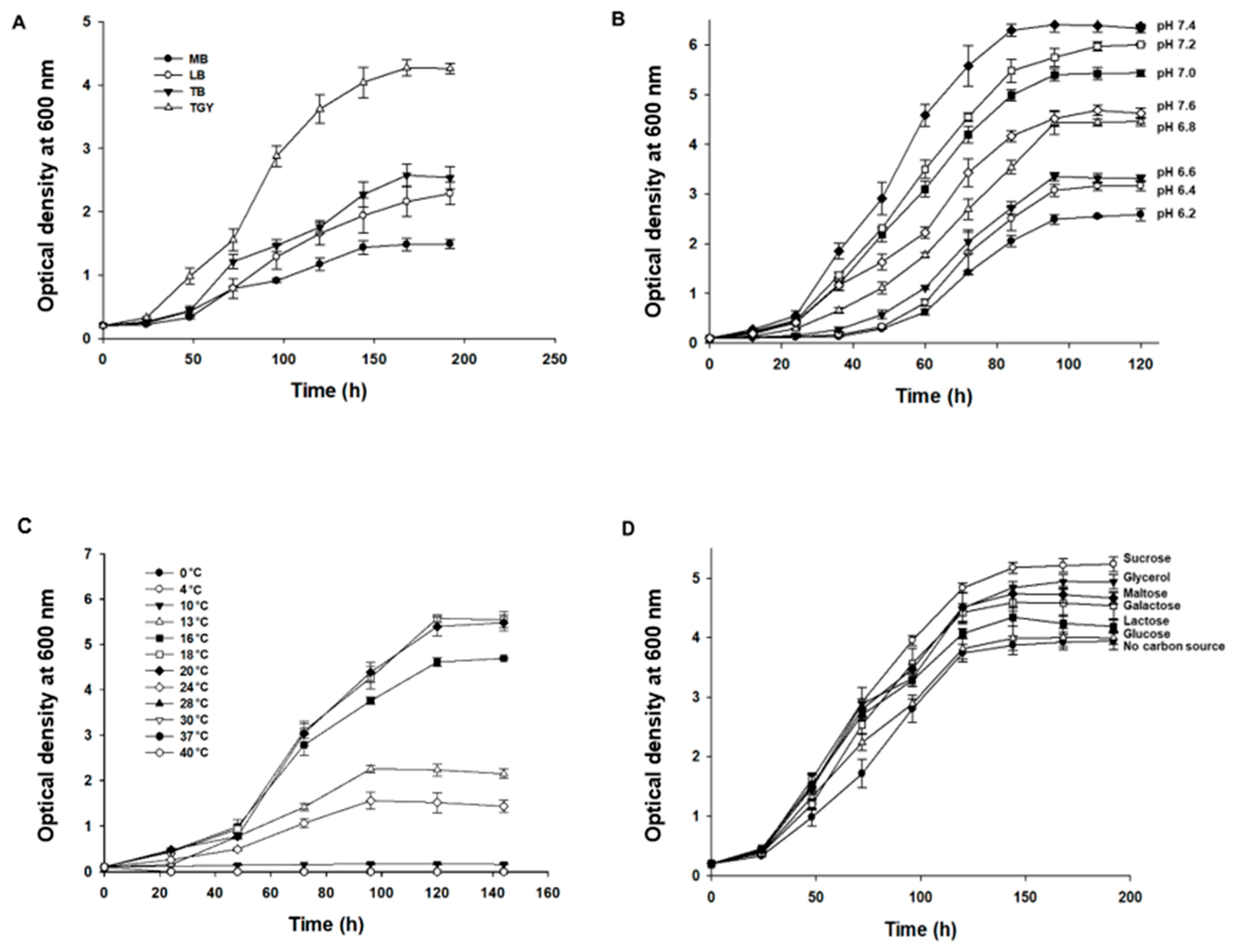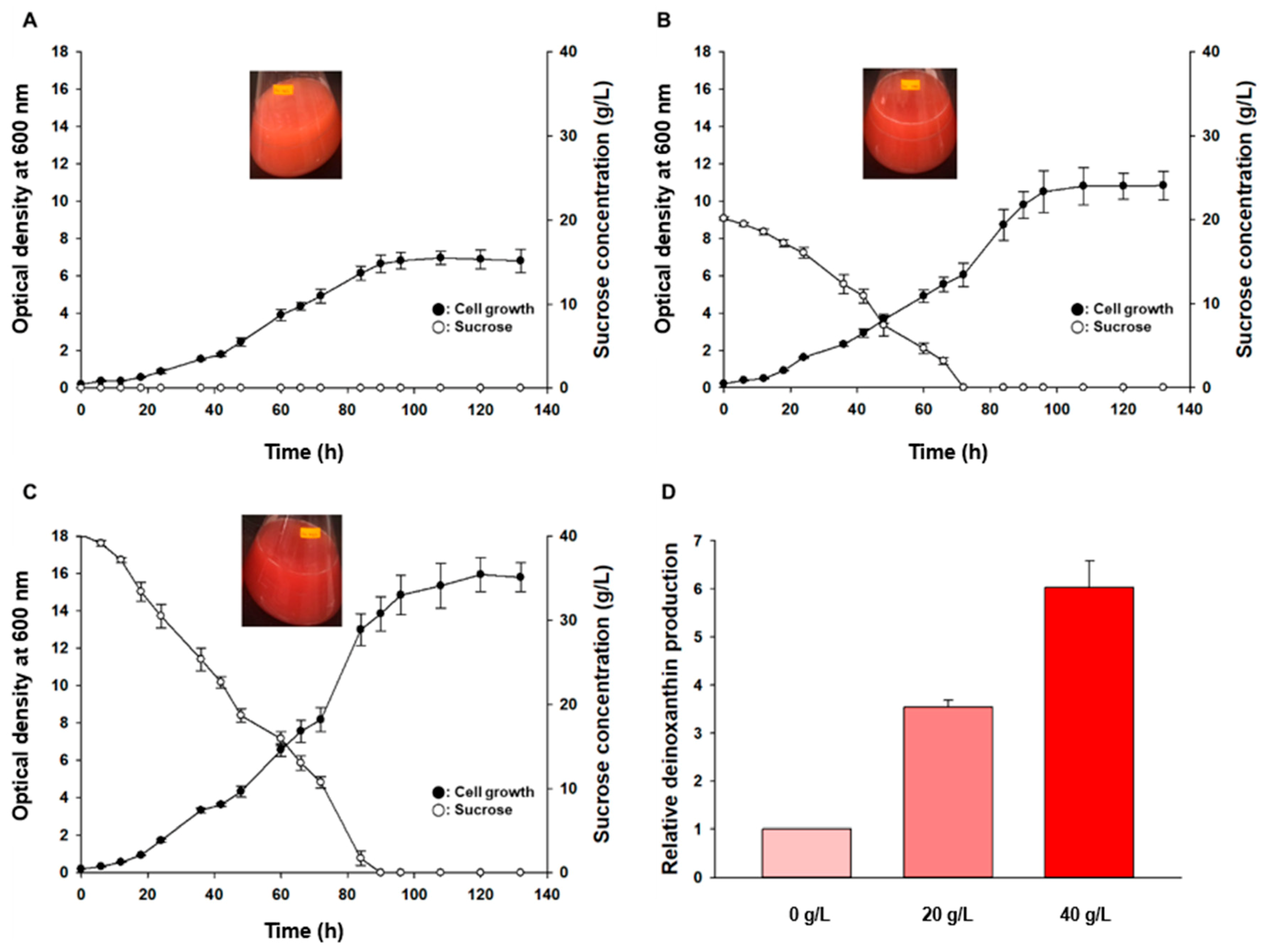Characterization of Carotenoid Biosynthesis in Newly Isolated Deinococcus sp. AJ005 and Investigation of the Effects of Environmental Conditions on Cell Growth and Carotenoid Biosynthesis
Abstract
1. Introduction
2. Results and Discussion
2.1. Characterization of Carotenoids of Deinococcus Sp. AJ005
2.2. The Proposed Carotenoid Biosynthetic Pathway and Genes Encoding Putative Carotenogenic Enzymes in Deinococcus Sp. AJ005
2.3. Effects of Culture Media, Culture pH, and Temperature on Cell Growth
2.4. Batch Fermentation Involving Deinococcus sp. AJ005 for Carotenoid Production
3. Materials and Methods
3.1. Flask Fermentation Involving Deinococcus Sp. AJ005
3.2. Bioreactor Fermentation by Deinococcus Sp. AJ005
3.3. Extraction and Analysis of Carotenoids
3.4. Monitoring Cell Growth and Quantification of Carbohydrates and Carotenoids
4. Conclusions
Author Contributions
Funding
Conflicts of Interest
References
- Yoo, S.H.; Weon, H.Y.; Kim, S.J.; Kim, Y.S.; Kim, B.Y.; Kwon, S.W. Deinococcus aerolatus sp. nov. and Deinococcus aerophilus sp. nov., isolated from air samples. Int. J. Syst. Evol. Microbiol. 2010, 60, 1191–1195. [Google Scholar] [CrossRef] [PubMed]
- Dong, N.; Li, H.R.; Yuan, M.; Zhang, X.H.; Yu, Y. Deinococcus antarcticus sp. nov., isolated from soil. Int. J. Syst. Evol. Microbiol. 2015, 65, 331–335. [Google Scholar] [CrossRef] [PubMed]
- Rainey, F.A.; Ray, K.; Ferreira, M.; Gatz, B.Z.; Nobre, F.; Bagaley, D.; Rash, B.A.; Park, M.J.; Earl, A.M.; Shank, N.C.; et al. Extensive Diversity of Ionizing-Radiation-Resistant Bacteria Recovered from Sonoran Desert Soil and Description of Nine New Species of the Genus Deinococcus Obtained from a Single Soil Sample. Appl. Environ. Microbiol. 2005, 71, 5225–5235. [Google Scholar] [CrossRef] [PubMed]
- Yang, Y.; Itoh, T.; Yokobori, S.; Itahashi, S.; Shimada, H.; Satoh, K.; Ohba, H.; Narumi, I.; Yamagishi, A. Deinococcus aerius sp. nov., isolated from the high atmosphere. Int. J. Syst. Evol. Microbiol. 2009, 59, 1862–1866. [Google Scholar] [CrossRef]
- Yang, Y.; Itoh, T.; Yokobori, S.; Shimada, H.; Itahashi, S.; Satoh, K.; Ohba, H.; Narumi, I.; Yamagishi, A. Deinococcus aetherius sp. nov., isolated from the stratosphere. Int. J. Syst. Evol. Microbiol. 2010, 60, 776–779. [Google Scholar] [CrossRef]
- Callegan, R.P.; Nobre, M.F.; McTernan, P.M.; Battista, J.R.; Navarro-Gonzalez, R.; McKay, C.P.; da Costa, M.S.; Rainey, F.A. Description of four novel psychrophilic, ionizing radiation-sensitive Deinococcus species from alpine environments. Int. J. Syst. Evol. Microbiol. 2008, 58, 1252–1258. [Google Scholar] [CrossRef]
- Shashidhar, R.; Bandekar, J.R. Deinococcus piscis sp. nov., a radiation-resistant bacterium isolated from a marine fish. Int. J. Syst. Evol. Microbiol. 2009, 59, 2714–2717. [Google Scholar] [CrossRef]
- Hirsch, P.; Gallikowski, C.A.; Siebert, J.; Peissl, K.; Kroppenstedt, R.; Schumann, P.; Stackebrandt, E.; Anderson, R. Deinococcus frigens sp. nov., Deinococcus saxicola sp. nov., and Deinococcus marmoris sp. nov., low temperature and draught-tolerating, UV-resistant bacteria from continental Antarctica. Int. J. Syst. Evol. Microbiol. 2004, 27, 636–645. [Google Scholar] [CrossRef]
- Cox, M.M.; Keck, J.L.; Battista, J.R. Rising from the Ashes: DNA Repair in Deinococcus radiodurans. PLoS Genet. 2010, 6, e1000815. [Google Scholar] [CrossRef]
- Lange, C.C.; Wackett, L.P.; Minton, K.W.; Daly, M.J. Engineering a recombinant Deinococcus radiodurans for organopollutant degradation in radioactive mixed waste environments. Netw. Address Transl. 1998, 16, 929–933. [Google Scholar] [CrossRef]
- Brim, H.; Osborne, J.P.; Kostandarithes, H.M.; Fredrickson, J.K.; Wackett, L.P.; Daly, M.J. Deinococcus radiodurans engineered for complete toluene degradation facilitates Cr(VI) reduction. Microbiology 2006, 152, 2469–2477. [Google Scholar] [CrossRef] [PubMed]
- Lemee, L.; Peuchant, E.; Clerc, M.; Brunner, M.; Pfander, H. Deinoxanthin: A new carotenoid isolated from Deinococcus Radiodurans. Tetrahedron Lett. 1997, 53, 919–926. [Google Scholar] [CrossRef]
- Bamji, M.S.; Krinsky, N.I. The carotenoid pigments of a radiation-resistant Micrococcus species. Biochim. Biophys. Acta 1966, 115, 276–284. [Google Scholar] [CrossRef]
- Ji, H.F. Insight into the strong antioxidant activity of deinoxanthin, a unique carotenoid in Deinococcus radiodurans. Int. J. Mol. Sci. 2010, 11, 4506–4510. [Google Scholar] [CrossRef] [PubMed]
- Tian, B.; Xu, Z.; Sun, Z.; Lin, J.; Hua, Y. Evaluation of the antioxidant effects of carotenoids from Deinococcus radiodurans through targeted mutagenesis, chemiluminescence, and DNA damage analyses. Biochim. Biophys. Acta 2007, 1770, 902–911. [Google Scholar] [CrossRef] [PubMed]
- Choi, Y.J.; Hur, J.M.; Lim, S.; Jo, M.; Kim, D.H.; Choi, J.I. Induction of apoptosis by deinoxanthin in human cancer cells. Anticancer Res. 2014, 34, 1829–1835. [Google Scholar] [PubMed]
- Leuko, S.; Bohmeier, M.; Hanke, F.; Boettger, U.; Rabbow, E.; Parpart, A.; Rettberg, P.; de Vera, J.P. On the Stability of Deinoxanthin Exposed to Mars Conditions during a Long-Term Space Mission and Implications for Biomarker Detection on Other Planets. Front. Microbiol. 2017, 8, 1680. [Google Scholar] [CrossRef]
- Schmidt, R. Deactivation of O2(1Δg) Singlet Oxygen by Carotenoids: Internal Conversion of Excited Encounter Complexes. J. Phys. Chem. A 2004, 108, 5509–5513. [Google Scholar] [CrossRef]
- Mayne, S.T. Beta-carotene, carotenoids, and disease prevention in humans. FASEB J. 1996, 10, 690–701. [Google Scholar] [CrossRef]
- Choi, J.Y.; Lee, K.; Lee, P.C. Complete genome sequence of the carotenoid-producing Deinococcus sp. strain AJ005. Microbiol. Resour. Announc. 2019, 8, e01245-19. [Google Scholar] [CrossRef]
- Hansler, A.; Chen, Q.; Ma, Y.; Gross, S.S. Untargeted metabolite profiling reveals that nitric oxide bioynthesis is an endogenous modulator of carotenoid biosynthesis in Deinococcus radiodurans and is required for extreme ionizing radiation resistance. Arch. Biochem. 2016, 589, 38–52. [Google Scholar] [CrossRef] [PubMed]
- Zhou, Z.; Zhang, W.; Su, S.; Chen, M.; Lu, W.; Lin, M.; Molnar, I.; Xu, Y. CYP287A1 is a carotenoid 2-beta-hydroxylase required for deinoxanthin biosynthesis in Deinococcus radiodurans R1. Appl. Microbiol. Biotechnol. 2015, 99, 10539–10546. [Google Scholar] [CrossRef] [PubMed]






© 2019 by the authors. Licensee MDPI, Basel, Switzerland. This article is an open access article distributed under the terms and conditions of the Creative Commons Attribution (CC BY) license (http://creativecommons.org/licenses/by/4.0/).
Share and Cite
Choi, J.Y.; Lee, K.; Lee, P.C. Characterization of Carotenoid Biosynthesis in Newly Isolated Deinococcus sp. AJ005 and Investigation of the Effects of Environmental Conditions on Cell Growth and Carotenoid Biosynthesis. Mar. Drugs 2019, 17, 705. https://doi.org/10.3390/md17120705
Choi JY, Lee K, Lee PC. Characterization of Carotenoid Biosynthesis in Newly Isolated Deinococcus sp. AJ005 and Investigation of the Effects of Environmental Conditions on Cell Growth and Carotenoid Biosynthesis. Marine Drugs. 2019; 17(12):705. https://doi.org/10.3390/md17120705
Chicago/Turabian StyleChoi, Jun Young, Kunjoong Lee, and Pyung Cheon Lee. 2019. "Characterization of Carotenoid Biosynthesis in Newly Isolated Deinococcus sp. AJ005 and Investigation of the Effects of Environmental Conditions on Cell Growth and Carotenoid Biosynthesis" Marine Drugs 17, no. 12: 705. https://doi.org/10.3390/md17120705
APA StyleChoi, J. Y., Lee, K., & Lee, P. C. (2019). Characterization of Carotenoid Biosynthesis in Newly Isolated Deinococcus sp. AJ005 and Investigation of the Effects of Environmental Conditions on Cell Growth and Carotenoid Biosynthesis. Marine Drugs, 17(12), 705. https://doi.org/10.3390/md17120705





